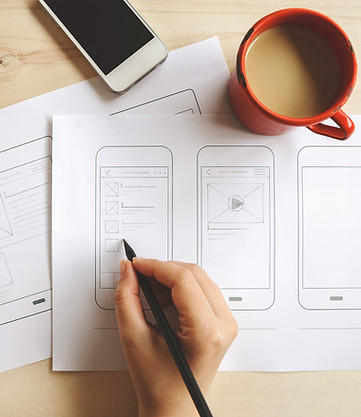
DESIGN LAB
A 4-week course on UX Research & Strategy. Introducing techniques to help to research, validate, and gain insight on customers. Here you will find the different projects I completed to get my certificate.
THE REASON
As a Product Designer, I was aware of several UX concepts. With this Bootcamp, I was able to finally get all my ideas in order and to apply all my knowledge using Design Thinking as a guide to connect concepts and discover new ones. It helped me to discover myself.
The Bootcamp was perfectly designed around my career goals as it contains practical components, plus theory. Through it, I was able to convert my existing knowledge of UX into a portfolio that proves and presents my job-ready skills. It included personal mentorship, and Jonah McLachlan, a UX expert, was able to guide me through the entire process and clear all my doubts.
TIMELINE
4 weeks course.
MENTOR
KEY GOAL
Improve my UX skills
and create a UX portfolio.
MY ROLE
This course gave me the possibility to dove into design thinking with different immersive projects.
The course could be carried out under 2 premises: a personal project or one proposed by Design Lab. In my case, it seemed appropriate to take the opportunity and work on an unknown topic for me, so I selected the case presented by the course.
It was a great challenge for me to work in something new, a totally unknown niche, instead of working in something that I already knew and for which I already had many answers. I took the Design Lab proposal as if it were a new client, who came with new ideas and possibilities to research.
Research subject: Big market for people wanting to change their behavior (eat less, exercise more, save more money, read more, practice guitar more, etc.). The client wanted to create an app to help people reach their goals.

BREAKING DOWN THE PROCESS
In my personal opinion, the key to this entire Bootcamp was having the possibility of discussing all subjects with a mentor.
Jonah was the person in charge of clearing all my doubts.
Every time I was learning a new concept I was starting to have different concerns. Having Jonah, was like having a research team. I was able to share my concerns and points of view and he was able to do the same.
A few of my concerns were:
-
How are we sure about which type of research to use?
-
How detailed should be a problem space in order to start the research?
-
How do I know I’m doing the correct research or I’m using the correct methodology?
Some research is better than none and your research will be always guided by the goal of the project. You can conduct multiple research methods in order to understand an entire project. We must always cover 3 things about users: their goals, their context, and their behavior.
While there are variants of the process, "Design Thinking" has come to be defined as the combination of the following: empathy for the context of a problem, creativity in the generation of insights and solutions, and rationality in analyzing and fitting various solutions to the problem context.

Design Thinking it's a user-centered design methodology that we can use to guide us through our research process — we can apply its methods to analyze complex problems and come up with innovative solutions.
THESE WERE SOME MAJOR LEARNINGS OR POINTS WE WANTED TO CALL OUT
Empathize
When we acknowledge we are not the customer, we attempt to understand our users at a deeply human level.
We need to understand the emotional, social, and irrational drivers that affect the way our users behave.
We design for a diverse range of people.
Define
At this stage, we give meaning to the data collected in our research.
Data is not knowledge.
We need to make sure we are solving the right problem.
Data is taken, organized, patterns are sought, and knowledge is extracted.
Ideate
From the Define stage, we get different Points of View and this is the moment where we start looking for ways to solve user problems.
In this stage, your ideas are shared with your teammates in order to brainstorm.
In this stage, we are in a CREATIVE MODE.
Prototype
This stage is where UI design begins.
A first prototype is created in order to be tested. because it's better to develop a prototype as soon as possible, as cheaply as possible, rather than spending lots of money creating a product and launching it only to find out that it fails.
Test
The testing phase is the best opportunity to improve our products by studying how people interact with our ideas. It can be daunting for people to get feedback directly from customers, but it can also be hugely empowering as well.
The objective is to learn more about the people and the problem and to inform potential solutions.

TITLE OF THE CALLOUT BLOCK
LESSONS LEARNED
The next stage of the design process would be to actually start designing and building your product, but with this course, I was able to cover all the concepts that will conduct every research I will be involved in the future.
First time working with these concepts, I got confused a lot! I went from an idea — a set of assumptions and beliefs about a product that could work — and did the legwork to learn all about hypothetical users and their needs. I conducted research, synthesized data and insight into artifacts to share with teams (like personas and empathy maps), and generated ideas based on this. Finally, I quickly prototyped examples of the solution designed and got feedback from possible users.
This course gave me a strong understanding of the research process and its importance, and know the techniques used to conduct research and generate artifacts.






